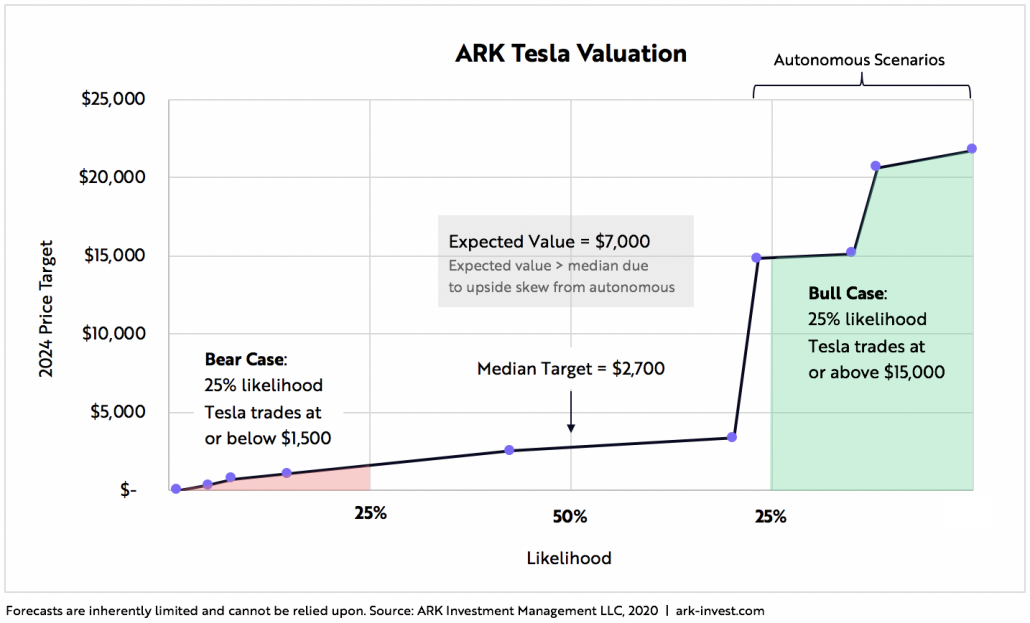ARK Invest focuses solely on offering investment solutions to capture disruptive innovation in the public equity markets. ARK believes that the world is rapidly changing and passive investment strategies are counterproductive. ARK also believes that innovation is causing disruption and the risks associated with the traditional world order are rising. Therefore ARK invests at the pace of innovation. ARK’s analysts are organized by a cross-sector innovation theme to capitalize on technological convergence across markets and industries.
“We’re all about finding the next big thing. Those hewing to the benchmarks, which are backwards looking, are not about the future. They are about what has worked. We’re all about what is going to work.” — Catherine D. Wood, CEO ARK Invest.
Tasha Keeney joined ARK in 2014 and is an Analyst for ARK’s Autonomous Technology and Robotics strategy. Keeney covers autonomous cars, additive manufacturing, infrastructure development, and innovative materials. Keeney frequently appears on CNBC, CNN, Bloomberg, and Fox Business. She has been quoted and her research has been featured in The Wall Street Journal, Forbes, Wired, The Verge, Bloomberg, CNNMoney, and MarketWatch, among other publications.
Catherine D. “Cathie” Wood, founder and CEO of ARK Investment Management, with Tasha Keeney, analyst at ARK, and Elon Musk in 2018.
In 2020, Keeney and ARK had projected Tesla to be the first car manufacturer to reach a $1 trillion market capitalization. ARK did not believe that the pandemic would have a negative impact on the long-term value of disruptive companies like Tesla. In fact, based on their March 2020 expectations for electric vehicle (EV) cost declines and demand, as well as our estimates for the potential profitability of robo-taxis, ARK estimated that by 2024, the expected value per share for $TSLA would be $7,000, with a bullish target of $15,000. ARK is currently developing a new forecast on Tesla that will be published in 2021. ARK’s research and modeling in 2020 pointed to three key independent variables that are critical to understanding Tesla’s potential:
Gross Margins: Will Tesla’s cost of manufacturing vehicles continue to fall in line with Wright’s Law? If so, what will be the average selling price of Tesla’s vehicles?Capital Efficiency: What is Tesla’s cost per unit to build new production capacity?Autonomous Capability: Can Tesla launch a fully autonomous taxi service successfully?


ARK Invest probability distribution for TSLA price target 2020-2024 — projection from March 2020.
ARK Invest
At the time of this article, Tesla’s market cap is $845 billion (Jan. 26, 2021). Tesla is the most valuable and disruptive car manufacturer in the world. To learn more about Tesla and other disruptive technologies that will shape the digital economy, Ray Wang, CEO of Constellation Research, and I invited Tasha Keeney, autonomous vehicle investment analyst at ARK, to our weekly show DisrupTV. Here are the key takeaways of our discussion with Tasha Keeney of ARK Invest:
Tesla is the clear leader in eclectic vehicles. In 2018, ARK estimated that Tesla is three years ahead of all its competitors. Today, Keeney believes that Tesla could be 4 years ahead of all other EV manufacturers. Battery Day in September 2020 clearly demonstrated Tesla’s innovation capabilities and potential to produce a $25,000 car. Battery costs are declining, and Tesla is following the battery cost curve faster than other competitors. EVs are getting cheaper and reaching a demand inflection point. Tesla’s leadership in the market is perhaps undisputed but the 3- to 4-year window of differentiation is perhaps debatable
Tesla will be the first car manufacturer to reach a $1 trillion market capitalization. ARK will update its 2020 forecast in the upcoming weeks-months. The most recent research from Keeney shows Tesla’s potential in the ride-hailing services with human drivers ahead of full autonomy. Keeney assigns a 30% likelihood of developing a fully autonomous vehicle, noting Tesla is most likely to do this given its training data sourced from its customer fleet. Ride-hailing provides Tesla an opportunity to de-risk the fully autonomy goals by providing Tesla a recurring revenue stream with higher margins. Tesla also has a competitive advantage over Uber and Lyft because it can vertically integrate with insurers, and it is cheaper per mile to drive a Tesla, allowing it to reduce costs or pay drivers more. Keeney estimates that a new ride-hailing business model can add $30 billion in operating earnings for Tesla by 2025. Keeney believes that ride-hailing opportunities would launch in key ride-hail cities in California and then expand to other regions. Tesla’s ride-hailing service will also provide the additional data that it can use to further enhance its autonomous EV algorithms and capabilities. We spoke about Elon Musk moving to Texas and its impact on future business forecasts. ARK’s forecasting algorithms are solely based on cost advantages in batteries, autonomous driving, and global scale. As compared to other autonomous EV competitors, Tesla’s use of customer data provides a massive competitive advantage in terms of data volume and scale.
Tesla can provide better insights to the insurance companies or deliver its own services. Tesla can use the ride-hailing services to see what is happening with its cars better than any insurance company in the world. The data advantage can provide Tesla better margins for its insurance services.
The autonomous vehicle technology stack is based on a combinations of new technologies. Autonomous vehicle designs provide a blueprint for digital business transformation.
The inevitable future of medium to large businesses is the autonomous enterprise https://t.co/EocaTwzoga pic.twitter.com/ybgDLTl5B0
— Vala Afshar (@ValaAfshar) March 18, 2020
The Boring Company is not boring at all. Keeney’s forecasts that at scale, an autonomous taxi can price profitably to the consumer at 25 cents per mile — that is 1/10 the cost of ride-hail or taxis today, and 1/2 the cost of riding your personal car. These cost-savings can accelerate the ride-hail market. And traffic can significantly increase in the future. The Boring Company can address the traffic increase and offer a solution to circumvent the increase and provide the most cost-effective infrastructure.
I encourage you to watch the full video with Tasha Keeney to learn more about thematic investments and ARK’s unique approach to delivering value to clients. ARK’s thematic investment strategies span market capitalizations, sectors, and geographies to focus on public companies that they expect to be the leaders, enablers, and beneficiaries of disruptive innovation. ARK employs an open research approach that adds technology concepts and external inputs to traditional financial research, creating a more transparent and interdisciplinary investment process. Keeney also shared her forecast on 3D printing and accelerated adoption of the technology since the pandemic.



